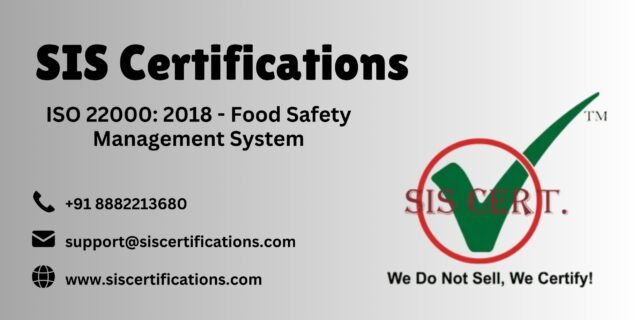Overview of ISO 22000 Certification
ISO 22000 Certification is an international standard designed to ensure food safety across the entire food supply chain. Developed by the International Organization for Standardization (ISO), it integrates the principles of Hazard Analysis and Critical Control Points (HACCP) with other management system elements to create a comprehensive FSMS. This certification is applicable to organizations of all sizes and types, including farms, food manufacturers, packaging companies, and catering services.
The primary goal of ISO 22000 Certification is to ensure that food is safe for consumption by identifying and controlling potential hazards—biological, chemical, or physical—at every stage of production. By achieving this certification, businesses demonstrate their commitment to food safety, enhance their market reputation, and gain a competitive edge in the global marketplace. Additionally, it facilitates compliance with international regulations, making it easier for organizations to expand into new markets.
ISO 22000 Certification Cost
The cost of obtaining ISO 22000 Certification varies depending on several factors, including the size and complexity of the organization, the scope of the FSMS, and the certification body chosen. Key cost components include:
- Gap Analysis and Preparation: Organizations often conduct a gap analysis to assess their current food safety practices against ISO 22000 requirements. This may involve hiring consultants, with costs ranging from $2,000 to $10,000, depending on the organization’s size.
- Training: Employees need training on ISO 22000 standards and FSMS implementation. Training programs can cost between $500 and $5,000, depending on the number of employees and the training format (online or in-person).
- Implementation Costs: Developing and implementing an FSMS involves updating processes, documentation, and infrastructure. These costs can range from $5,000 to $20,000, particularly for organizations requiring significant upgrades.
- Certification Audit: The external audit by an accredited certification body typically costs between $3,000 and $15,000, depending on the organization’s size and audit duration.
- Maintenance and Surveillance Audits: Post-certification, annual surveillance audits (costing $1,000–$5,000) and recertification audits every three years (similar to initial audit costs) are required to maintain certification.
Small businesses may spend $10,000–$20,000 in total, while larger organizations with complex operations could incur costs exceeding $50,000. Investing in ISO 22000 Certification yields long-term benefits, such as reduced risk of food safety incidents and enhanced marketability.
ISO 22000 Certifications
ISO 22000 Certification is a single, unified standard, but it can be tailored to various sectors within the food supply chain. There are no distinct “types” of ISO 22000 certifications; however, related standards complement it:
- ISO 22000:2018: The latest version of the standard, updated to align with modern food safety challenges and incorporate the ISO High-Level Structure (HLS) for easier integration with other management systems like ISO 9001 (quality) or ISO 14001 (environmental).
- FSSC 22000: A certification scheme based on ISO 22000, combined with additional requirements (e.g., ISO/TS 22002-1 for food manufacturing). It is recognized by the Global Food Safety Initiative (GFSI) and preferred by some retailers.
- ISO 22002 Series: These are technical specifications that support ISO 22000, covering prerequisites for specific sectors like catering, farming, or packaging.
While ISO 22000 Certification is versatile, organizations may choose complementary certifications based on their industry needs or market demands.
ISO 22000 Certification Requirements
To achieve ISO 22000 Certification, organizations must meet specific requirements outlined in the ISO 22000:2018 standard. These include:
- Food Safety Management System (FSMS): Establish, document, implement, and maintain an FSMS that aligns with ISO 22000 standards.
- Management Commitment: Top management must demonstrate leadership and commitment to food safety, including setting policies and objectives.
- Hazard Analysis and Control: Conduct a hazard analysis to identify potential food safety risks and establish critical control points (CCPs) to manage them.
- Prerequisite Programs (PRPs): Implement PRPs, such as good manufacturing practices (GMP), sanitation, and pest control, to ensure a hygienic environment.
- Documentation: Maintain comprehensive records, including food safety policies, procedures, hazard analyses, and monitoring results.
- Internal Audits: Conduct regular internal audits to evaluate the FSMS’s effectiveness and identify areas for improvement.
- Continuous Improvement: Establish processes for corrective actions and continuous improvement to address non-conformities and enhance the FSMS.
Compliance with these requirements ensures that organizations systematically manage food safety risks and maintain high standards.
ISO 22000 Certification Process
The process of obtaining ISO 22000 Certification involves several steps, typically taking 6–12 months depending on the organization’s readiness:
- Gap Analysis: Assess current food safety practices against ISO 22000 requirements to identify gaps and develop an implementation plan.
- FSMS Development: Design and document the FSMS, including policies, procedures, and PRPs tailored to the organization’s operations.
- Training and Implementation: Train staff on ISO 22000 requirements and implement the FSMS across all relevant processes.
- Internal Audit: Conduct an internal audit to verify the FSMS’s effectiveness and address any non-conformities.
- Management Review: Top management reviews the FSMS to ensure it aligns with organizational goals and ISO 22000 standards.
- Certification Audit: An accredited certification body conducts a two-stage audit:
- Stage 1: A documentation review to assess FSMS readiness.
- Stage 2: An on-site audit to verify implementation and compliance.
- Certification Issuance: If the audit is successful, the certification body issues the ISO 22000 Certification, valid for three years.
- Surveillance and Recertification: Annual surveillance audits ensure ongoing compliance, with a full recertification audit every three years.
This structured process ensures that organizations achieve and maintain high food safety standards.
ISO 22000 Standard
The ISO 22000 Standard, specifically ISO 22000:2018, is built on a risk-based approach to food safety management. Key elements include:
- Plan-Do-Check-Act (PDCA) Cycle: The standard follows the PDCA cycle to ensure continuous improvement in the FSMS.
- HACCP Principles: Integrates HACCP principles to identify, evaluate, and control food safety hazards.
- Prerequisite Programs (PRPs): Establishes foundational practices, such as hygiene, sanitation, and facility maintenance, to support food safety.
- Operational Prerequisite Programs (OPRPs): Identifies specific control measures to manage significant hazards that are not critical control points.
- Traceability and Recall: Requires systems for tracking products and managing recalls in case of safety issues.
- Communication: Emphasizes effective internal and external communication to ensure food safety across the supply chain.
The 2018 revision aligns with the ISO High-Level Structure, making it easier to integrate with other standards and adapt to evolving food safety challenges.
FAQs
Q1: What is ISO 22000 Certification?
A: ISO 22000 Certification is an international standard that certifies an organization’s food safety management system, ensuring safe food production and compliance with regulatory requirements.
Q2: Who can apply for ISO 22000 Certification?
A: Any organization in the food supply chain, including producers, manufacturers, distributors, and retailers, can apply for ISO 22000 Certification.
Q3: How long does it take to get certified?
A: The process typically takes 6–12 months, depending on the organization’s size, complexity, and readiness.
Q4: What are the benefits of ISO 22000 Certification?
A: Benefits include enhanced food safety, regulatory compliance, improved market reputation, and access to global markets.
Q5: How often is recertification required?
A: Certification is valid for three years, with annual surveillance audits and a recertification audit every three years.
Q6: Is ISO 22000 mandatory?
A: While not mandatory, ISO 22000 Certification is often required by regulators, customers, or retailers to demonstrate food safety compliance.
Conclusion
ISO 22000 Certification is a cornerstone of food safety excellence, offering organizations a structured approach to managing risks and ensuring high-quality products. By achieving this certification, businesses demonstrate their commitment to consumer safety, regulatory compliance, and operational efficiency. While the costs and process may require significant investment, the benefits—enhanced reputation, market access, and reduced risk—far outweigh the challenges. Whether you’re a small producer or a multinational food manufacturer, ISO 22000 Certification is a strategic step toward building trust and achieving long-term success in the global food industry. Embrace this standard to elevate your food safety practices and stay ahead in a competitive market.







